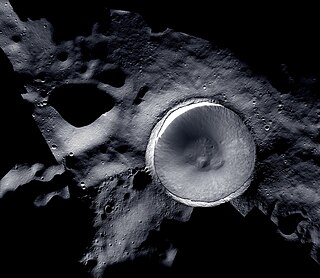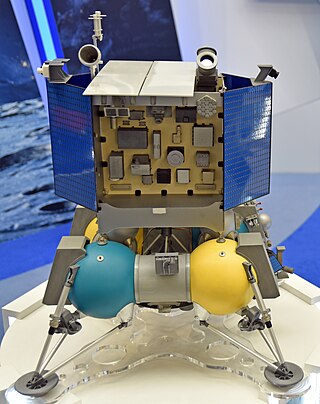
A Moon landing or lunar landing is the arrival of a spacecraft on the surface of the Moon, including both crewed and robotic missions. The first human-made object to touch the Moon was Luna 2 in 1959.

A lunar lander or Moon lander is a spacecraft designed to land on the surface of the Moon. As of 2024, the Apollo Lunar Module is the only lunar lander to have ever been used in human spaceflight, completing six lunar landings from 1969 to 1972 during the United States' Apollo Program. Several robotic landers have reached the surface, and some have returned samples to Earth.

Astrobotic Technology, Inc., commonly referred to as Astrobotic, is an American private company that is developing space robotics technology for lunar and planetary missions. It was founded in 2007 by Carnegie Mellon professor Red Whittaker and his associates with the goal of winning the Google Lunar X Prize. The company is based in Pittsburgh, Pennsylvania. Their first launch occurred on January 8, 2024, as part of NASA's Commercial Lunar Payload Services (CLPS) program. The launch carried the company's Peregrine lunar lander on board the first flight of the Vulcan Centaur rocket from Florida's Space Force Station LC-41. The mission was unable to reach the Moon for a soft or hard landing. On June 11, 2020, Astrobotic received a second contract for the CLPS program. NASA would pay Astrobotic US$199.5 million to take the VIPER rover to the Moon, targeting a landing in November 2024. In July 2024, NASA announced that VIPER had been cancelled.

The lunar south pole is the southernmost point on the Moon. It is of interest to scientists because of the occurrence of water ice in permanently shadowed areas around it. The lunar south pole region features craters that are unique in that the near-constant sunlight does not reach their interior. Such craters are cold traps that contain fossil records of hydrogen, water ice, and other volatiles dating from the early Solar System. In contrast, the lunar north pole region exhibits a much lower quantity of similarly sheltered craters.

Luna 27 is a planned lunar lander mission by the Roscosmos with collaboration by the European Space Agency (ESA) to send a lander to the South Pole–Aitken basin, an area on the far side of the Moon. Its objective will be to detect and characterise lunar polar volatiles. The mission is a continuation of the Luna-Glob programme.

Resource Prospector is a cancelled mission concept by NASA of a rover that would have performed a survey expedition on a polar region of the Moon. The rover was to attempt to detect and map the location of volatiles such as hydrogen, oxygen and lunar water which could foster more affordable and sustainable human exploration to the Moon, Mars, and other Solar System bodies.
The International Lunar Observatory (ILO) is a private scientific and commercial lunar mission by the International Lunar Observatory Association of Kamuela, Hawaii to place a permanent observatory near the South Pole of the Moon to conduct astrophysical studies using an optical telescope and possibly an antenna dish. The mission aims to prove a conceptual design for a lunar observatory that would be reliable, low cost, and fast to implement. A precursor mission, ILO-X consisting of two small imagers, launched on 15 February 2024 aboard the Intuitive Machines IM-1 mission to the Moon south pole region. It is hoped to be a technology precursor to a future observatories on the Moon, and other commercial initiatives.
MoonLIGHT is a laser retroreflector developed as a collaboration primarily between the University of Maryland in the United States, and the Italian National Institute for Nuclear Physics - National Laboratories of Frascati (INFN-LNF) to complement and expand on the Lunar Laser Ranging experiment started with the Apollo Program in 1969. MoonLIGHT was planned to be launched in July 2020 as a secondary payload on the MX-1E lunar lander built by the private company Moon Express. However, as of February 2020, the launch of the MX-1E has been canceled. In 2018 INFN proposed to the European Space Agency (ESA) the MoonLIGHT Pointing Actuators (MPAc) project and was contracted by ESA to deliver it. MPAc is an INFN development for ESA, with auxiliary support by the Italian Space Agency (ASI) for prototyping work. In 2021, ESA agreed with NASA to launch MPAc with a Commercial Lunar Payload Services (CLPS) mission. Nova-C, the lander on which MPAc will be integrated, is designed by Intuitive Machines and the landing site is Reiner Gamma. The expected launch date of the Nova-C mission carrying the instrument, IM-3, is in 2025.

Commercial Lunar Payload Services (CLPS) is a NASA program to hire companies to send small robotic landers and rovers to the Moon. Most landing sites are near the lunar south pole where they will scout for lunar resources, test in situ resource utilization (ISRU) concepts, and perform lunar science to support the Artemis lunar program. CLPS is intended to buy end-to-end payload services between Earth and the lunar surface using fixed-price contracts. The program achieved the first landing on the Moon by a commercial company in history with the IM-1 mission in 2024. The program was extended to add support for large payloads starting after 2025.

The Intuitive Machines Nova-C, or simply Nova-C, is a class of lunar landers designed by Intuitive Machines (IM) to deliver small payloads to the surface of the Moon. Intuitive Machines was one of three service providers awarded task orders in 2019 for delivery of NASA science payloads to the Moon. The IM-1 lunar lander, named Odysseus, was launched by a SpaceX Falcon 9 rocket on 15 February 2024, reached lunar orbit on 21 February, and landed on the lunar surface on 22 February. This marked the inaugural Nova-C landing on the Moon and the first American spacecraft to perform a soft landing on the Moon in over 50 years. It is the first spacecraft to use methalox propulsion to navigate between the Earth and the Moon.

Intuitive Machines, Inc. is an American space exploration company headquartered in Houston, Texas. It was founded in 2013 by Stephen Altemus, Kam Ghaffarian, and Tim Crain, to provide commercial and government exploration of the Moon. Today the Company offers lunar surface access for transportation and payload delivery, data transmission services, and infrastructure-as-a-service. Intuitive Machines holds three NASA contracts under the space agency's Commercial Lunar Payload Services (CLPS) initiative, to deliver payloads to the lunar surface. Intuitive Machines is one of three companies selected by NASA to advance Lunar Terrain Vehicle (LTV). capabilities.
The Lunar Polar Exploration Mission (LUPEX), is a planned joint lunar mission by the Indian Space Research Organisation (ISRO) and Japan Aerospace Exploration Agency (JAXA). The mission would send an uncrewed lunar lander and rover to explore the south pole region of the Moon no earlier than 2028. It is envisaged to explore the permanently shadowed regions and to determine the quantity and quality of water on the Moon. JAXA is likely to provide the H3 launch vehicle and the rover, while ISRO would be providing the lander.

The Moon bears substantial natural resources which could be exploited in the future. Potential lunar resources may encompass processable materials such as volatiles and minerals, along with geologic structures such as lava tubes that, together, might enable lunar habitation. The use of resources on the Moon may provide a means of reducing the cost and risk of lunar exploration and beyond.

VIPER is a lunar rover which was developed at the NASA Ames Research Center. Before the project was cancelled in 2024 the rover would have been tasked with prospecting for lunar resources in permanently shadowed areas of lunar south pole region, especially by mapping the distribution and concentration of water ice. The mission built on a previous NASA rover concept, the Resource Prospector, which had been cancelled in 2018.

IM-1 was a robotic Moon landing mission conducted by Intuitive Machines (IM) in February 2024 using a Nova-C lunar lander. After contact with the lunar surface on February 22 the lander tipped to an unplanned 30 degree angle. All instrument payloads remained functional and the mission was deemed a success. IM-1 was the first commercial mission to successfully soft-land on the Moon. NASA provided funding support for the mission through the Commercial Lunar Payload Services program. The lander, named Odysseus, carried six NASA-developed payloads and several others from commercial and educational customers. On February 29, Odysseus lost power and shut down with the start of the lunar night.

IM-2 is an upcoming lunar mission that will be carried in late February 2025 by Intuitive Machines for NASA's CLPS program, using a Nova-C lunar lander. The company named this lander Athena. The mission aims to uncover the presence and amount of lunar water ice using PRIME-1, which consists of a drill and mass spectrometer. The lander will carry a Micro Nova Hopper, a drone that will utilize its neutron spectrometer in the PSR of the nearby Marston crater. If successful, this would provide the first measurement of hydrogen on the surface in the PSR, a key indicator of water.
Jacqueline Quinn is an American engineer and inventor. She was one of the inventors of emulsified zerovalent iron, an environmentally safe material that can remove chlorinated solvent contaminants left from space exploration. She was inducted into the National Inventors Hall of Fame in 2018.
Firefly Aerospace Blue Ghost, or simply Blue Ghost, is a class of lunar landers designed and manufactured by Firefly Aerospace (Firefly). Firefly plans to operate Blue Ghost landers to deliver small payloads to the surface of the Moon. The first Blue Ghost mission is scheduled to launch at 1:11 a.m. EST on January 15, 2025.
Lunar Outpost is a private space company headquartered in Arvada, Colorado, USA. It is an industry leader in the areas of space robotics, lunar surface mobility and space resources. The company has developed the Mobile Autonomous Prospecting Platform (MAPP) rover, and also holds a contract to develop a Lunar Terrain Vehicle (LTV) for the Artemis Program.












